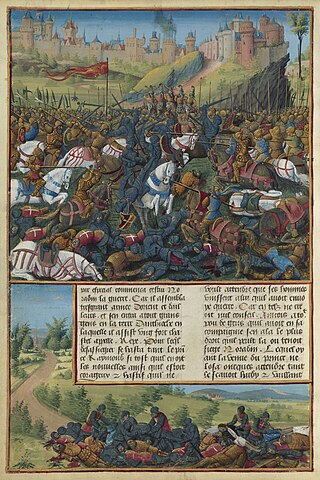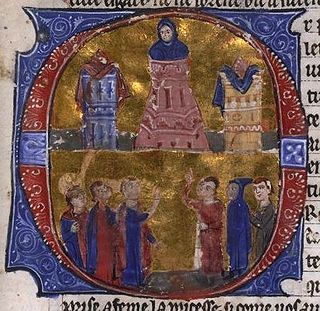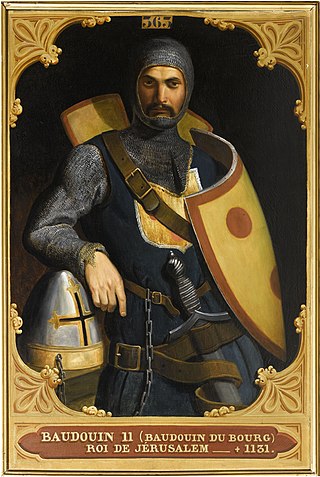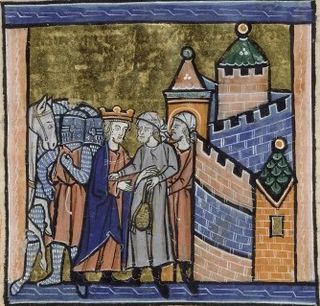
The Second Crusade (1147-1150) was the second major crusade launched from Europe. The Second Crusade was started in response to the fall of the County of Edessa in 1144 to the forces of Zengi. The county had been founded during the First Crusade (1096–1099) by King Baldwin I of Jerusalem in 1098. While it was the first Crusader state to be founded, it was also the first to fall.

Baldwin III was King of Jerusalem from 1143 to 1163. He was the eldest son of Melisende and Fulk of Jerusalem. He became king while still a child, and was at first overshadowed by his mother Melisende, whom he eventually defeated in a civil war. During his reign Jerusalem became more closely allied with the Byzantine Empire, and the Second Crusade tried and failed to conquer Damascus. Baldwin captured the important Egyptian fortress of Ascalon, but also had to deal with the increasing power of Nur ad-Din in Syria. He died childless and was succeeded by his brother Amalric.

Raynald of Châtillon, also known as Reynald, Reginald, or Renaud, was a knight of French origin who became Prince of Antioch from 1153 to 1160 or 1161 and Lord of Oultrejordain from 1175 until his death. The second son of a French noble family, he joined the Second Crusade in 1147, and settled in the Kingdom of Jerusalem as a mercenary. Six years later, he married Constance, Princess of Antioch, in spite of her subjects' opposition.

Qiwam al-Dawla Kerbogha, known as Kerbogha or Karbughā, was atabeg of Mosul during the First Crusade and was renowned as a soldier.
Imad al-Din Zengi, also romanized as Zangi, Zengui, Zenki, and Zanki, was a Turkoman atabeg, who ruled Mosul, Aleppo, Hama, and, later, Edessa. He was the namesake of the Zengid dynasty.

Nūr al-Dīn Maḥmūd Zengī, commonly known as Nur ad-Din, was a member of the Zengid dynasty, which ruled the Syrian province of the Seljuk Empire. He reigned from 1146 to 1174. He is regarded as an important figure of the Second Crusade.

The Crusader states, or Outremer, were four Catholic polities that existed in the Levant from 1098 to 1291. Following the principals of feudalism, the foundation for these polities was laid by the First Crusade, which was proclaimed by the Latin Church in 1095 in order to reclaim the Holy Land after it was lost to the 7th-century Muslim conquest. Situated on the Eastern Mediterranean, the four states were, in order from north to south: the County of Edessa (1098–1150), the Principality of Antioch (1098–1268), the County of Tripoli (1102–1289), and the Kingdom of Jerusalem (1099–1291). The three northern states covered an area in what is now southeastern Turkey, northwestern Syria, and northern Lebanon; and the Kingdom of Jerusalem, the southernmost and most prominent state, covered an area in what is now Israel, the State of Palestine, southern Lebanon, and western Jordan. The description "Crusader states" can be misleading, as from 1130 onwards, very few people among the Franks were Crusaders. Medieval and modern writers use the term "Outremer" as a synonym, derived from the French word for overseas.

Joscelin II was the fourth and last ruling count of Edessa. He was son of his predecessor, Joscelin I, and Beatrice, daughter of Constantine I of Armenia.

The Battle of Inab, also called Battle of Ard al-Hâtim or Fons Muratus, was fought on 29 June 1149, during the Second Crusade. The Zengid army of Atabeg Nur ad-Din Zangi destroyed the combined army of Prince Raymond of Poitiers and the Assassins of Ali ibn-Wafa. The Principality of Antioch was subsequently pillaged and reduced in size as its eastern border was pushed west.

The siege of Edessa took place from 28 November to 24 December 1144, resulting in the fall of the capital of the County of Edessa to Zengi, the atabeg of Mosul and Aleppo. This event was the catalyst for the Second Crusade.
Mu'in ad-Din Unur al-Atabeki was a mid-12th century ruler of Damascus from 1140 to 1149. He was a Turkoman slave of Burid emirs.

Shaizar or Shayzar is a town in northern Syria, administratively part of the Hama Governorate, located northwest of Hama. Nearby localities include, Mahardah, Tremseh, Kafr Hud, Khunayzir and Halfaya. According to the Syria Central Bureau of Statistics (CBS), Shaizar had a population of 5,953 in the 2004 census.

The Battle of Sarmin, also known as the Battle of Tell Danith, took place on September 14, 1115 with Roger of Salerno's Crusader army surprising and routing the Seljuk Turkish army of Bursuq ibn Bursuq of Hamadan. It is also known as the First Battle of Tell Danith, distinguishing it from the Battle of Hab of 1119, the Second Battle of Tell Danith.

The Crusades were a series of religious wars initiated, supported, and sometimes directed by the Christian Latin Church in the medieval period. The best known of these military expeditions are those to the Holy Land in the period between 1095 and 1291 that were intended to reconquer Jerusalem and its surrounding area from Muslim rule. Beginning with the First Crusade, which resulted in the conquest of Jerusalem in 1099, dozens of military campaigns were organised, providing a focal point of European history for centuries. Crusading declined rapidly after the 15th century.

Between 780–1180, the Byzantine Empire and the Abbasid & Fatimid caliphates in the regions of Iraq, Palestine, Syria, Anatolia and Southern Italy fought a series of wars for supremacy in the Eastern Mediterranean. After a period of indecisive and slow border warfare, a string of almost unbroken Byzantine victories in the late 10th and early 11th centuries allowed three Byzantine Emperors, namely Nikephoros II Phokas, John I Tzimiskes and finally Basil II to recapture territory lost to the Muslim conquests in the 7th century Arab–Byzantine wars under the failing Heraclian Dynasty.
The military history of the Crusader states begins with the formation of the County of Edessa in 1097 and ends with the loss of Ruad in 1302, the last Christian stronghold in the Holy Land.
Zahir al-Din Toghtekin or Tughtekin, also spelled Tughtegin, was a Turkoman military leader, who was emir of Damascus from 1104 to 1128. He was the founder of the Burid dynasty of Damascus.
In the Battle of Ba'rin, also known as Battle of Montferrand) in 1137, a Crusader force commanded by King Fulk of Jerusalem was scattered and defeated by Zengi, the atabeg of Mosul and Aleppo. This setback resulted in the permanent loss of the Crusader castle of Montferrand in Baarin.

The siege of Shaizar took place from April 28 to May 21, 1138. The allied forces of the Byzantine Empire, Principality of Antioch and County of Edessa invaded Muslim Syria. Having been repulsed from their main objective, the city of Aleppo, the combined Christian armies took a number of fortified settlements by assault and finally besieged Shaizar, the capital of the Munqidhite Emirate. The siege captured the city, but failed to take the citadel; it resulted in the Emir of Shaizar paying an indemnity and becoming the vassal of the Byzantine emperor. The forces of Zengi, the greatest Muslim prince of the region, skirmished with the allied army but it was too strong for them to risk battle. The campaign underlined the limited nature of Byzantine suzerainty over the northern Crusader states and the lack of common purpose between the Latin princes and the Byzantine emperor.

The timeline of the Principality of Antioch is a chronological list of events of the history of the Principality of Antioch.













